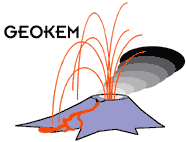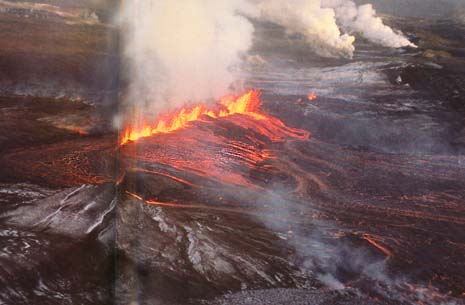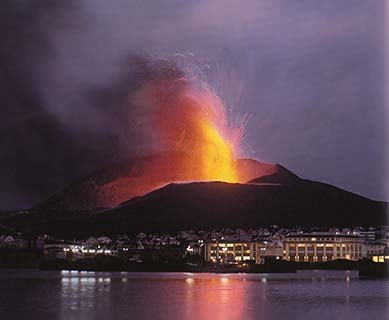 The Rare Earth Elements The Rare Earth Elements
The Rare Earth Elements (REE) are unusual in that all 15 have the same outer electron configuration, therefore they tend to have similar chemical behaviour. Twenty years ago there were great hopes that the REE would show constant ratios no matter what processes they had been subject to, but this proved to be a false hope, in fact they differ as much as do the other residual elements.
The Lanthanides used are (in plot order):
La, Ce, Pr, Nd, Pm, Sm, Eu, Gd, Tb, Dy, Ho, Er, Tm, Yb, Lu
The range of REE in common rocks of oceanic mantle origin is quite wide. Here are some average values for La. Ce can be taken as being approx double in most rocks though the ratio varies from about 2.3 to 1.8. Promethium is not found as it is unstable. Ce is usually 10-20 times as abundant as the heaviest rare earth - Lu, and the whole series show a curious alternating high-low level distribution. Below, see the actual values from East Pacific Rise. For this reason, REE diagrams are always normalised, traditionally to the carbonaceous chondrites. I often use the average enriched E-type MORB as it is something more positively known and of not such depleted composition. It is also close to the average oceanic crust.
 |
Actual levels of REE from from East Pacific Rise showing alternating pattern. |
TYPICAL Ce CONTENTS OF OCEANIC CRUST,(ppm):
|
|
EPR-Ferro-basalt
|
Mauna Kea Hawaiite
|
Island Phonolite
|
|
0.5 to 1.5
|
5 - 21
|
44 - 67
|
100 - 330
|
As shown above, in rocks derived from the sub-Oceanic mantle there is a wide range range of REE levels in common rocks, ranging from. eg, N-type MORBS from the SW Indian Ocean Rise, to Pu’u O’o (Kilauea, Hawaii), to the hawaiites of Mauna Kea where the light REE are present at about 10 times E-type. In lavas from the oceanic lithosphere therefore we have a range of a factor of 50 in the light REE while the heavy REE stay almost unchanged. We could extend this range further by looking for very alkaline basanites, and could add the effects of fractionation by including phonolites when we can get 100 - 300 times N-Type MORB levels.
|
|
REE of the East Pacific Rise-Galapagos area from 0 - 11N.
The lower samples are from the N-MORBs of the North Chilean Ridge showing how closely they conform to the more basic EPR. |
|
|
The REE for the Neovolcanic rocks of the Iceland Rift zones, (Chauvel & Hemond, 2000). The two obviously discordant samples near the top are alkali basalts from the Snaefellsness area in the most western area (see map, Oceanic Islands and OIB's, Iceland). The two concordant samples at the top are an hawaiite from the Vestmanneyar (islands) and a sample from Hekla. The Hekla-Katla area in the southern part of the East Rift Zone, while not alkaline, are rather enriched Icelandic andesite or "icelandite" type.
Note the very different appearance to the E.P.R. area. Compare also with the REE pattern of Hawaii. |
|
|
Examples illustrating the wide range of REE patterns to be found in the oceanic environment. Here we see the hawaiites of Mauna Kea, the Pu'u O'o lavas of Kilauea, and the very depleted Site 504 MORBS of the East Pacific Rise |
|
|
REE of Piton de la Fournaise, an active intra-plate picritic volcano on Reunion Island, Indian Ocean. Very similar to Kilauea, but slightly more alkaline with FM (ferro-magnesian index) ranging from 30 to 75.
Most evolved lavas are actually mugearites according to an Alk/Silica diagram. |
|
|
REE of N-type MORBS from the Reykjanes Ridge, SW of Iceland.
+ ODP Leg 73. N-Type MORB ridge basalts.
Note presence of two alkali basalts. |

Icelandic rift eruption (Like Laki and Hekla)
(Photo: National Geographic Magazine)
|
 |
Krafla, a major volcanic centre superimposed on the northern part of the East Rift Zone of Iceland. Ian Nicholson is thanked for allowing me to use his pre-publication PhD data. Krafla includes both depleted partial melts and higher crystal fractionates including more than one lineage of ferro-basalt, icelandite and oceanic rhyodacite. |
The more highly fractionated Krafla rocks overlap with the mugearites from the Vestmaneyjar Is, but these have no Eu anomaly.

Vestmanneyjar, Heimaey, Iceland, January 1973.
|
 |
Surtsey, Eldfell, Helgafell, Kirkufell etc are alkaline centres in the new Vestmaneyar Is off the south coast of Iceland, south of the East Rift Zone. |
If we compare these with the alkaline rocks of the Vesteris Seamount off E. Greenland, we see the slope is different, ie the Vesteris rocks are more light REE enriched.
Which series is the more “Alkaline”?
 |
REE of Vesteris Seamount (Greenland Sea) normalised to E-type MORB. |
The slope can be expressed by the La/Sm ratio or by La/Lu or by Ce/Yb which being present in greater amount means better accuracy. In general a fractionated series of samples will plot on a straight line passing through the origin. A group ranging from, say, tholeiite to transitional to alkaline to basanitic, will plot as a wide spread of differend trends with La/Lu ranging from 7-8 in tholeiites to as high as 1-200 in the most alkaline rocks.
The, most depleted NMORBs have a La/Sm (non-normalised) of 1 or even <1, ranging up to 7-8 in alkaline OIB's. Ce/Nd is also as low as 1 in NMORBs.
REE OF THE CONTINENTAL CRUST
Continental rocks do not show any distinctive differences in their REE patterns when compared to rocks of the Oceanic crust and alkali basalts from both environments are also similar. In all environments, more alkaline rocks are always light REE enriched. Ce contents for a series of island and continental arcs are shown below in ppm:
|
|
Active Arc IAB
|
Medium Andesite
|
High K andesite
|
Ultra-High-K
|
|
(West Pac)
|
(Tonga-Ker)
|
(NZ)
|
(Vesuvius)
|
(Tibet)
|
|
0.8 - 5
|
2-5
|
10-25
|
35-65
|
70-120
|
The Vesuvius potassic andesites have a La/Lu slope of not more than 10 compared to 7 for basanites from Vesteris. Primitive andesite series, ie island arcs, may have a La/Lu of 0.2 - 0.3 very like N-type MORBS
The most highly evolved of the Roman province rocks eg, the Campanian Ignimbrites, not only have La present at 25 times E-type levels but also show a marked Eu anomaly.
|
|
REE of primitive Island arc andesites, (South Sandwich Group).
+ Volcan Villarica, S. Cent. Chile. |
|
|
REE of mature arc; Mt Drum, Aleutian Arc.
+ Mt Taal, Philipine Is. |
|
|
REE of Potassic volcanoes, Muriah, W. Java
Pity we have no data for Tambora (Sumbawa)
|
|
|
Raoul Id, Early Arc, Kermadec Is.
At the bottom are the Proto-arc series from Tafahi, an active island of the Tongan arc, west of Samoa. |
|
|
Egmont Volcano NZ.
A typical Central Chilean-type andesite. |
|
|
Mt Vesuvius potassic andesites, Roman Province, Italy. |
|
|
Ultra-high-K andesite-rhyolites of Tibet. |
|
|
Campanian Ignimbrites, also part of the Roman Province.
Something seems to have affected the Er/Lu when we compare with Vesuvius. |
|
|
REE of Naivasha commendites, near Nairobi, Africa.
Now that is what I call a Europium anomaly! |
 |
Highly depleted NMORBs of the southern Reykjanes Ridge and more enriched EMORBs from north of 61N. |
REE behaviour in sediments is mainly similar to that for andesitic rocks, but in minerals it may be extreme. Thus apatite may have a total REE content of > 5400 ppm but as apatite is present in small amount in most rocks it has only a slight effect. However, the mineral monazite in granites has been found to have up 500,000 ppm total (Haskin, et al, 1966). This explains why sandstones may have as high or higher REE content compared to shales, as monazite is a detrital mineral.
High concentrations appear in manganese nodules which may have more than 99,000 ppm total REE. Phosphorites in marine sediments might be expected to take up REE as apatite is formed but total REE seldom exceeds 1000 ppm. Coexisting Cpx-Garnet as in eclogites show a marked preponderance of heavy REE in Gt but vey low levels are found in CPX. However in Cpx found in basaltic rocks together with plagioclase, it is the CPX which has high heavy REE.
Back
Copyright © 1998-2006 Dr B.M.Gunn
|